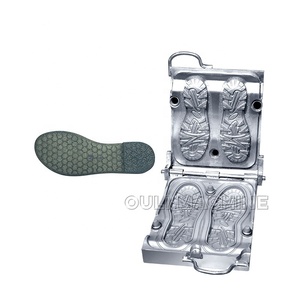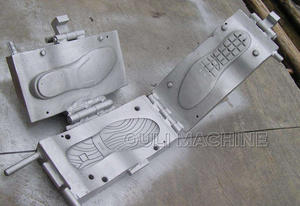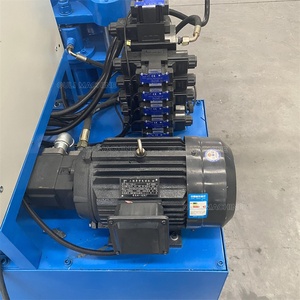
All categories
Featured selections
Trade Assurance
Buyer Central
Help Center
Get the app
Become a supplier

(3192 products available)













Outer sole cutting machine
An outer sole cutting machine is a machine that helps in cutting the rubber sole that is to be used on the outsole of shoes. The cutting machine first lays out the rubber material and then uses a die to cut out the outer sole according to the specific pattern set in by the program interface.
Buffing machine
A buffing machine is a device that helps to roughen the rubber sole after it has been cut. The roughening of the surface helps to ensure a stronger bond between the sole and the upper of the shoe. When applying adhesive to both surfaces, this increased surface area assists it in adhering better. Shoe buffing machines are sometimes used in the preparation of leather as well as rubber soles.
Rubber pressing machine
A rubber press machine is a device that helps in pressing and molding the rubber that will be used as the shoe sole. The machine heats the rubber and applies pressure to it in order to transform it into the die cavity's desired shape. The final step in the process before creating the actual rubber shoe sole is fitting the rubber sole into the mold and pressing it into shape. This will complete the forming process for the rubber shoe sole.
Cold stamping machine
A cold stamping machine for soles of shoes is a device that helps in the soles of shoes by carrying out the cold stamping process. This process entails the use of an adhesive to affix a pre-made shoe sole with a certain design to the bottom of the shoe. It is referred to as "cold stamping" since it does not need the use of heat or any other form of activation to perform the press fit bonding.
Shoe sole pressing machine
A shoe sole pressing machine is a device that helps to press the shoe sole onto the upper portion of the shoe. This machine ensures that the shoe sole is properly aligned and firmly attached to the shoe, providing a secure fit and finish.
Depending on the specific sole types they produce and the materials they work with, rubber sole-making machines come in various specifications. Here's a brief look at what to expect:
Like any other manufacturing machine, rubber sole-making machines will need routine check-up and repair services to maintain the rubber sole machine's best condition and ensure soles of good quality are made without disruptions caused by unexpected breakdowns.
The following are some essential maintenance tips to keep the sole-making machine in optimum condition and avoid breakdowns or damage to the soles:
Rubber sole-making machines are used extensively in the footwear industry. They help in manufacturing various types of rubber soles for shoes. However, they are not limited to just that. Sole-making machines are also used in the automotive and marine industries. They aid in creating rubber soles for sandals and slippers, respectively.
A lot of machines use heat and pressure to mold the shape of the sole. These include the compression molding machine and the injection molding machine. All these methods efficiently create rubber soles for different types of shoes.
Here are some specific examples of how sole-making machines are used:
When choosing a sole machine maker for business purposes, several key factors should be considered to ensure it aligns with production requirements, quality standards, and operational efficiency.
Production capacity and automation:
It's essential to match the machine's production capacity with demands. Consider the maximum number of soles the machine can produce within a specific time frame. Depending on the scale of operations, automation level is paramount. Automated machines streamline production processes, reduce manual intervention, boost efficiency, and improve consistency.
Quality and precision:
An efficient rubber sole-making machine should be chosen for business purposes because footwear quality is vital to customer satisfaction and business success. It should be capable of producing rubber soles of excellent quality that meet international standards. Opting for a machine that produces soles of precise dimensions, ensures a perfect fit, and is manufactured to exact specifications is essential to avoid potential customer complaints and product returns.
Flexible production lines and ease of use:
Studying how easy it is to operate and maintain the machine when choosing is important. A user-friendly machine can minimize training times and enhance workforce productivity. Additionally, machines that require minimal maintenance and are built to withstand wear and tear contribute to uninterrupted production and lower maintenance costs.
Compatible materials:
Compatible materials, including rubber, TPR, and PVC, are essential, as varying types and qualities of rubber are used in different manufacturing settings. Identifying a machine that accommodates a wide range of materials gives businesses greater flexibility in sourcing production inputs.
Q1: What materials does the rubber sole making machine use?
A1: The machine utilizes various rubber materials, including natural rubber, synthetic rubber, ethylene-vinyl acetate (EVA), and thermoplastic rubber (TPR).
Q2: Can the sole-making machine produce rubber soles for different types of footwear?
A2: Yes, rubber sole-making machines are designed to produce a wide variety of rubber soles, including flat soles, tread soles, high heels, and units for athletic shoes. However, the specific capabilities may vary depending on the model and type of machine.
Q3: Are the rubber soles made by the machine eco-friendly?
A3: The sole-making machines can use biodegradable materials like EVA to make environmentally friendly soles. Additionally, some machines may have processes that minimize waste during production.
Q4: Can a rubber sole-making machine be automated?
A4: Many modern rubber sole-making machines are fully automated, featuring computer-controlled systems for precise sole formation and efficient production.
Q5: What is the production capacity of a typical rubber sole-making machine?
A5: The production capacity can differ based on the machine's model, size, and level of automation. Some machines may produce a few hundred to several thousand rubber soles per day.